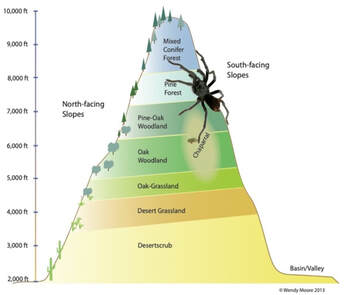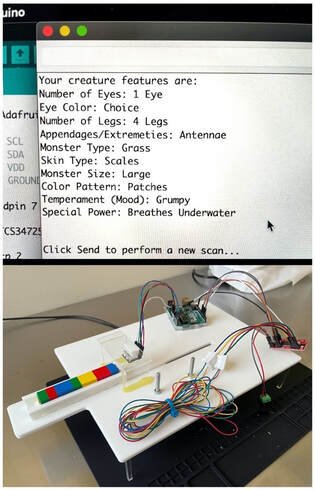|
written by: Eric Hartel Combining different schools of thought or discipline can lead to more meaningful discovery and understanding. The work of Dr. Chris Hamilton addresses this by studying Aphonopelma, a group of tarantulas that are found in the incredible and unique biome of sky islands in the southwestern United States and Mexico. This group of tarantulas are important as a marker for understanding the region, and hold a place of cultural significance in the San Carlos Apache creation story. What is a sky island you ask? They are made of mountain ranges that are surrounded by desert valleys. These mountains create interesting temperature and humidity gradients that play host to various stratified environments. These environments are similar to ocean islands because the deserts take the role of the impassable ocean, isolating organisms to specific islands if they can not cross the desert. The tarantulas in this area have no way to cross the large deserts and are partitioned into their niches across this area. The speciation and diversity of these tarantulas can shed light on the geologic history, evolution, and current state of this understudied diversity hot spot.  Figure 1 depicts an example of a single sky island. The stratified, stacked environments have provided multiple speciation events of endemic wildlife. Figure 1 depicts an example of a single sky island. The stratified, stacked environments have provided multiple speciation events of endemic wildlife. Dr. Hamilton described traveling up one of the sky island mountains as the equivalent of driving from the American southwest to Canada, making this region very unique. Studying the tarantulas in this incredibly understudied region can help to provide insights on how climate change has and will continue to impact this vital area. Aphonopelma are a great group to study in this area because they have no way to bridge these large desert valleys unlike other smaller species of spider that can let out long threads of silk and travel on air currents and are thought to have speciated when the mountain range formed, meaning their diversity and distribution is directly tied to the topography of the area. To study the speciation and diversity of these tarantulas, Dr. Hamilton has used comparative genetic analysis and extensive sampling to gather information on distribution. This careful study, sampling and examination have allowed Dr. Hamilton to redefine morphological definitions of many previously described species. This work has also led to the reclassification and discovery of many new species of Aphonopelma in the sky islands which is always interesting to see! Dr. Hamilton also works to incorporate Traditional Ecological Knowledge (TEK) into his work to address his research questions from a broader perspective, and to give back to the communities in the area of his work. TEK is the passed down knowledge that indigenous people have collected over generations. This information can be incredibly detailed on the way the natural cycles of an area affect the organisms living there and frequently “told”, or passed down, through song, dance, or oral stories. Dr. Hamilton used a very concrete example of TEK that really made the concept clear, by stating that iNaturalist is a Westernized example of TEK. The website iNaturalist is a crowd sourced database of information collected and tabulated like Western science research but built from any member of the community sharing their findings and learning from one another. Recently, the work in the sky islands has been limited to the United States however, Dr. Hamilton has been working to gain access to the southern portion of the sky islands by working with the Sky Island Alliance. This is a nonprofit that works on both sides of the border, and with the Mexican Government to obtain permits. He is hoping to make his first trip to Mexico this summer and to return many times in the coming years to further his work sampling, studying and classifying Aphonopelma in this bioregion.  Another key element of Dr. Hamilton’s work is in extension, working as a science communicator to school age tribal kids. He has been working to bring biology into the classroom with an interesting lesson for younger students and real laboratory work for high school students. The program for younger students is called “Monster Lab” which brings together the topics of heredity, alleles, and genotype versus phenotype. Seen in the images on the left are the outputs of different traits generated by genetic code that a student made (top), and the Arduino powered machine that reads the color sequence the students have made which generates the list of traits (bottom). The students then use what they have learned to make a “genetic code” for their personal monster, they can experiment and see how combinations of different genes affect how their monster turns out. The kids even get to draw a monster completely of their own creation, and share what they learned. At the high school level, Dr. Hamilton has been able to bring sampling kits into classrooms and teach students to preform actual genetic analysis like DNA extraction in a hands-on approach to help familiarize students with the possibilities of careers and build interest in STEM. Author: Eric Hartel, Masters student in the vanEngelsdorp bee lab. Comments are closed.
|
Categories
All
Archives
June 2024
|
Department of Entomology
University of Maryland
4112 Plant Sciences Building
College Park, MD 20742-4454
USA
Telephone: 301.405.3911
Fax: 301.314.9290
University of Maryland
4112 Plant Sciences Building
College Park, MD 20742-4454
USA
Telephone: 301.405.3911
Fax: 301.314.9290

 RSS Feed
RSS Feed




